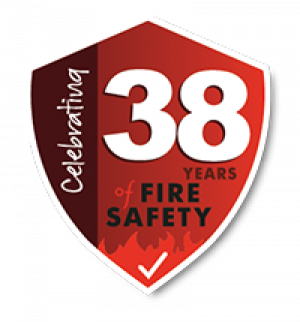Fire Suppression Mythbusters - Sprinkler Systems
24th Oct 2016

Sprinkler systems are an active fire protection method often installed in large workplaces, factories or areas of care. They consist of a large water supply that is piped into individual rooms from the ceiling that automatically begins spraying when a fire is detected.
Since their introduction in 1874, sprinklers have featured relatively heavily in film and television. They have been the method of escape, distraction, flood and damage in countless pieces across film and TV. Sprinkler systems are an active fire protection method
But has film and television tainted our view of sprinklers? Do we expect too much from them? As the responsible person, it’s your responsibility to understand how fire suppression techniques work, particulalry if overseeing your company's fire risk assessment.
Myth #1 - If you set off one sprinkler, they all go off.
We’ve all seen it in the films. The protagonist needs a diversion so they pull up a stool hold a cigarette lighter to the sprinkler head. This simple act activates the fire alarms and sets off every sprinkler in the building, creating just the distraction needed for them to make their escape.
However, this is not how the majority of sprinkler systems work. A sprinkler head releases water when it experiences heat above a certain temperature (Causing the glass valve to break), this releases the water. However, it only does so from that local sprinkler head. When you turn on your tap at home, it doesn’t turn on every one.
Not only are these systems simpler and less prone to failure, it also allows for that single open head to receive more water pressure. Sprinklers operate with a valve at the sprinkler head
Myth #2 - You can set off a sprinkler with a cigarette lighter or match.
Sprinklers operate with a valve at the sprinkler head that is held closed by an alcohol filled glass tube. The heat from the fire causes the alcohol inside the tube to expand and crack the glass tube at a specific temperature, thus opening the valve.
Providing that the lighter is held close enough to valve and for long enough to heat the bulb, it’s very possible that a lighter could activate a sprinkler head.
Myth #3 - Sprinklers will do more damage than fire.
It cannot be definitively proven that one will do more damage than the other; the potential for fire damage is endless. Whilst a sprinkler will cause water damage to the area of the fires source, the fire has the potential to do damage far beyond is origin and can destroy whole buildings if left uncontested.
What can be certain, however, is the use of sprinklers will cause less damage than a reliance on extinguishers and fire services alone. A sprinkler system can activate and contain a fire within minutes of the fire’s ignition. Emergency Fire Services will take over 10minutes from alert to begin dousing the fire with hoses.
Compare this with the fact that a sprinkler system dispenses 1/5th of the water per minute to contain a fire than a fire service hose or water jet and we can conclude that whilst water damage will occur, it’s less extensive than other systems.
Myth #4 - The sprinklers will activate every time the fire alarm goes off.
Most sprinkler systems are separate to alarm procedures. With the exception of deluge systems, sprinklers will not be activated by a fire alarm.
The majority of systems require heat to activate the sprinkler head and will not be triggered by fire alarms.
Myth #5 - Sprinkler systems are no good for chemical or electrical fires.
Sprinklers work using water for fire suppression which may not be suitable for applications where fire is electric or chemical based. Modern sprinkler systems can be ‘foam enhanced’ to give them the added ability to contain flammable liquid, chemical or petroleum fires. This gives them the ability to control a wider range of fires.
The only exception to all of the above is when a ‘Deluge’ system is installed. These systems are installed in places where rapid fire spread is likely and needs to be pre-empted so special systems are in place for their operation. They do not use individually activated sprinkler heads and can be activated by an alarm. These systems are often found in specialist environments.





